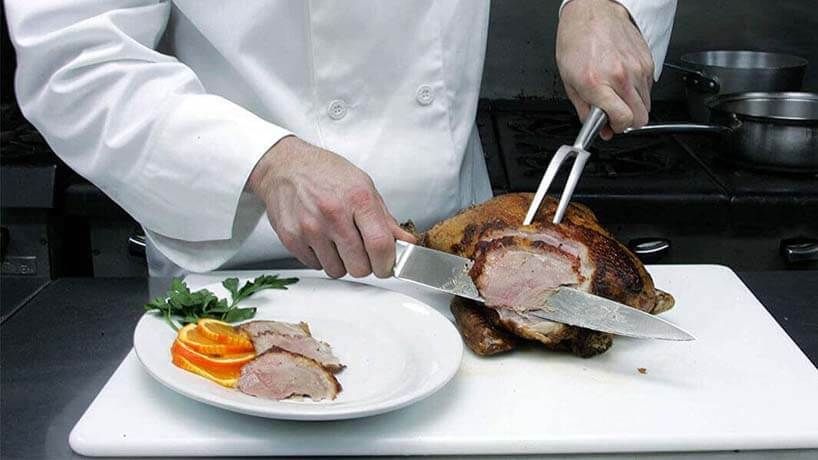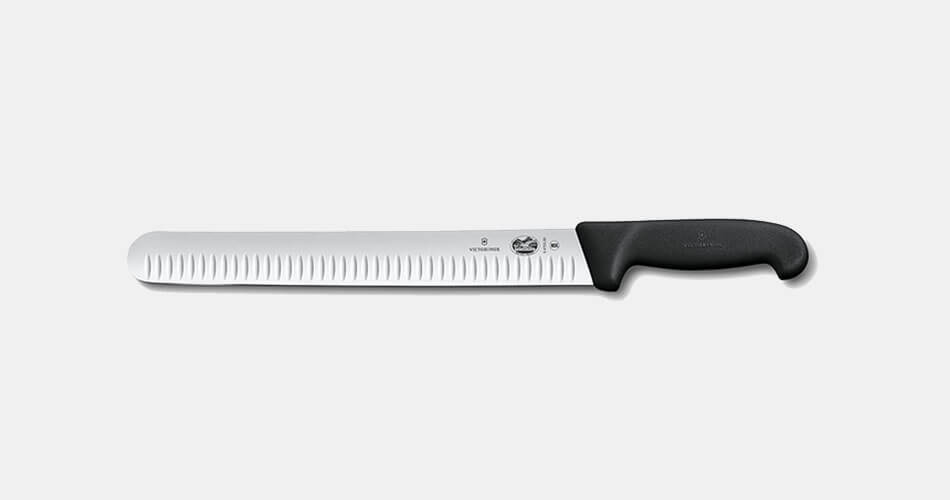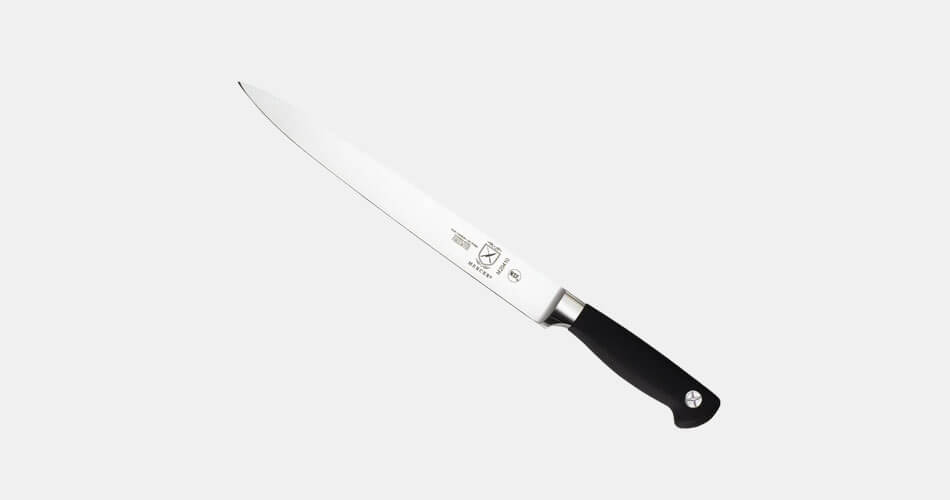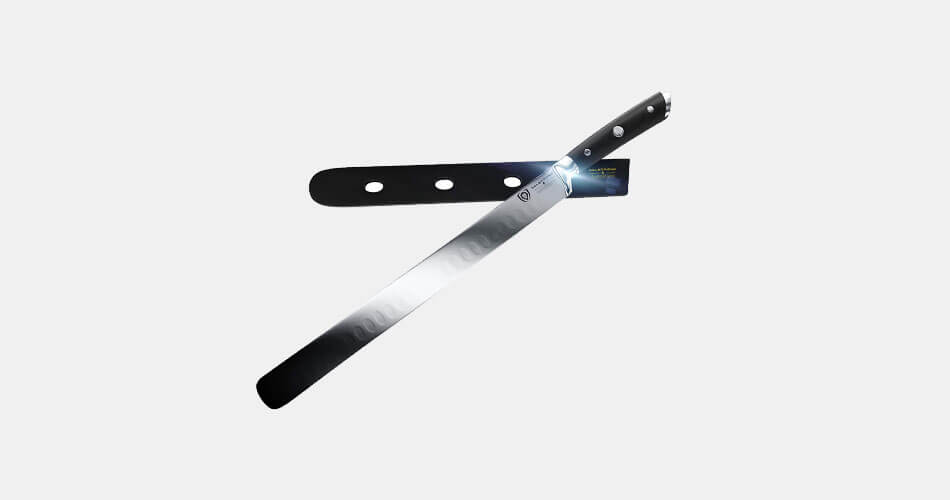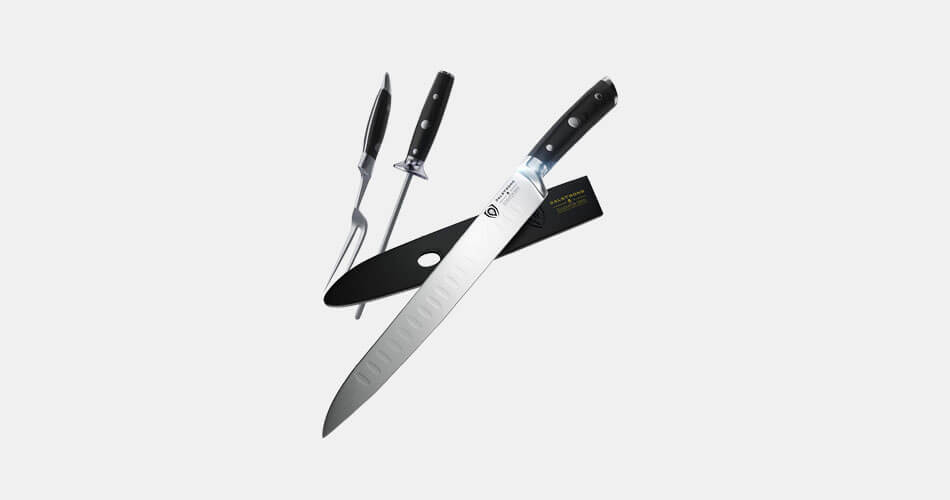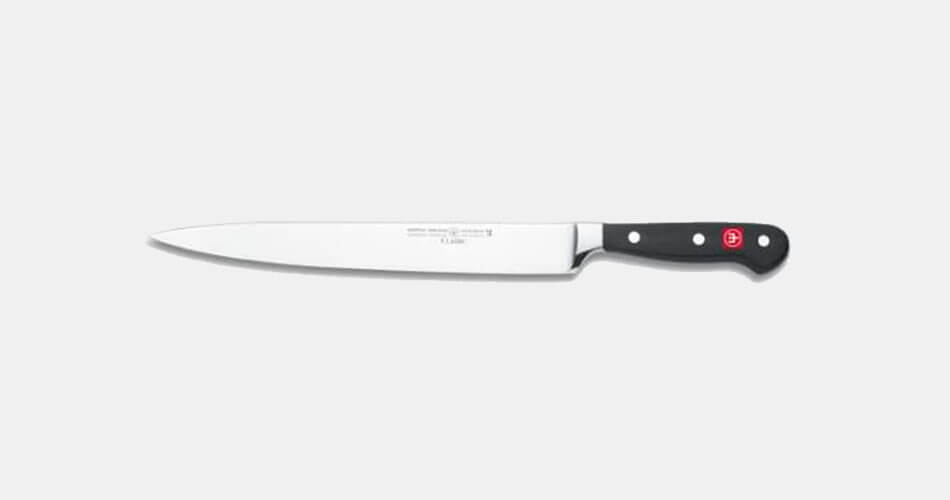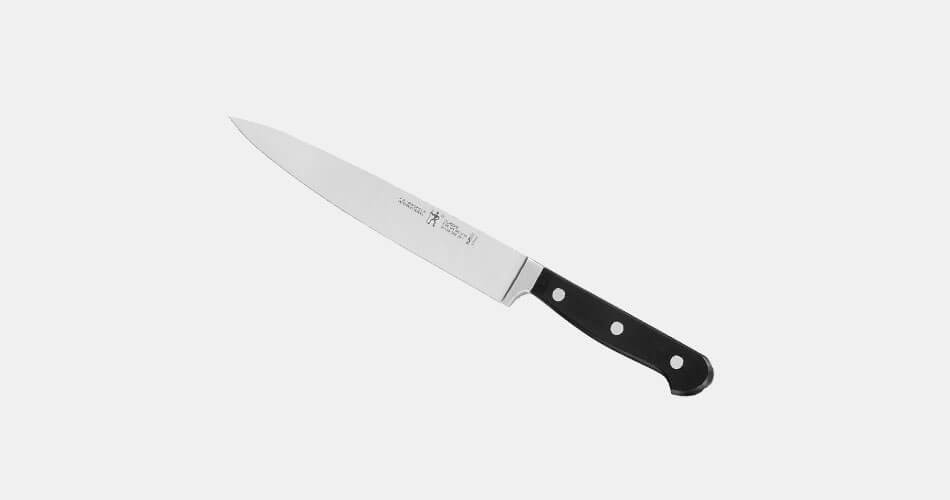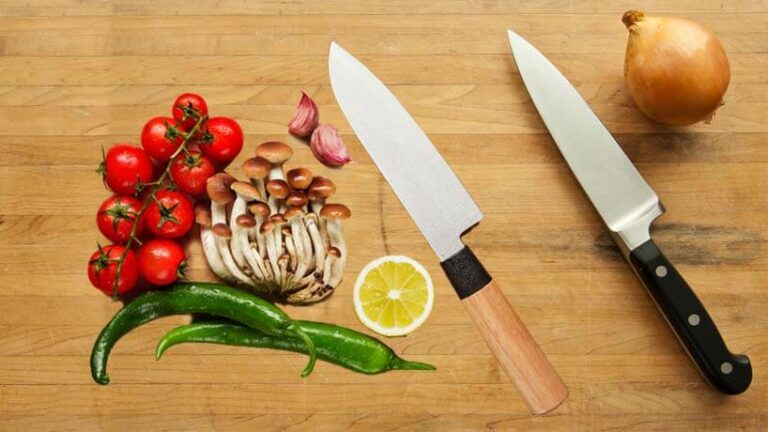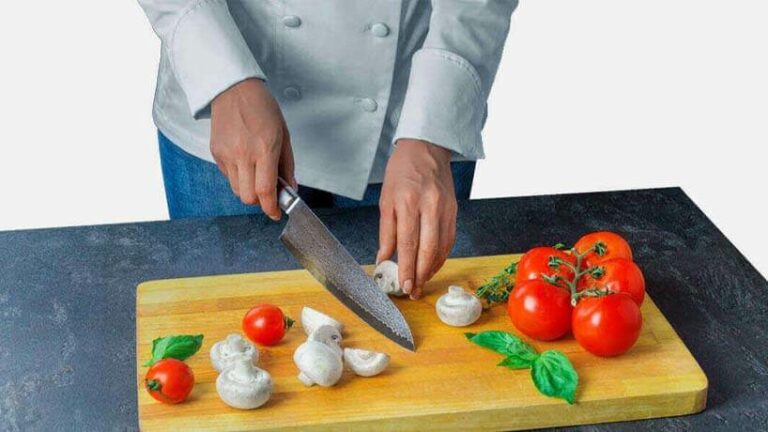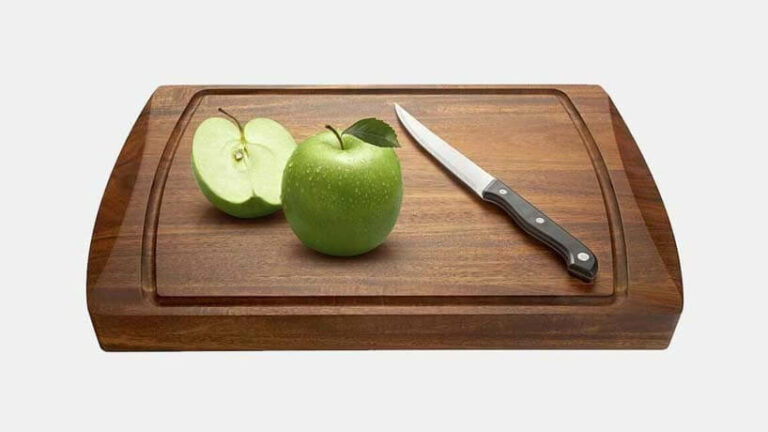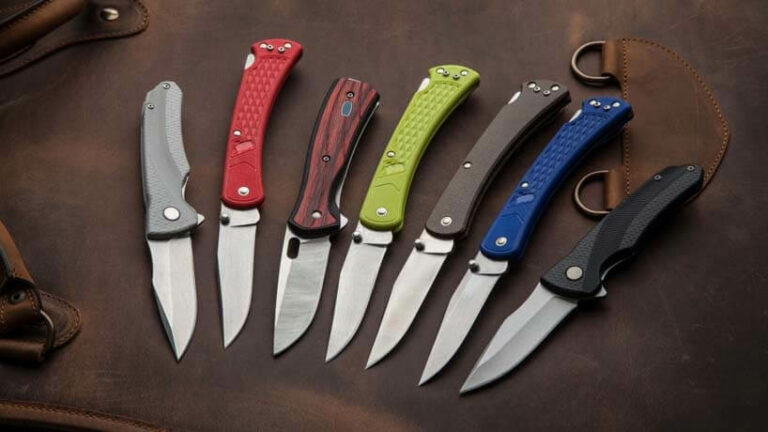We’ve all seen those ads that feature an unbelievably well-cut beef roast, with the meat rolling off the knife – it makes your mouth water doesn’t it? It comes down to skill and the tools you use, so hunting down the best carving knife is a good starting point.
There are a lot of carving knives on the market that don’t live up to their claims, and some that don’t give you value for money. Our guide will help make sure that you don’t miss out and have the best knife to get you the results you want. By the end of our guide, you’ll be ready and confident in choosing an excellent quality carving knife. Let’s go!
Top 10 Best Carving Knife Reviews in 2023
We’re going to take a look at carving knives that stand out above the rest. The knives that have made this list have been carefully selected based on a couple of different criteria (more on that later).
We’ll take a deeper look into each of the knives, what’s special about them, what you need to know, and what we liked and didn’t like about each one. You’ll be well-equipped to make a buying decision that’s intelligent and that gives you value for your money. Let’s get into our best carving knife reviews!
Victorinox Swiss Army Carving Knife
Here’s a 12” carving knife that’ll quickly become your go-to knife once you get used to handling it. The grip is excellent and works very well when it’s wet. Many large knives like this become tough to handle once it gets a little wet. You’ll be able to comfortably cut at different angles without having to squeeze the handle too hard.
It has a very sharp blade that can quickly cut through softer meats like turkey breast and tougher ones like prime rib. It’s versatile enough to use almost every day and the value for money is quite enticing. You might struggle to store it at a total length of over 17”. Overall, it’s a good pick for the best carving knife at this price and size.
- The blade has well-designed dimples across its length to create air pockets and let the meat fall off the knife better
- Fibrox grip is non-slip even when it’s wet
- The perfect balance between flexibility and rigidity to slice both soft and firm lumps of meat
- The knife doesn’t come with any type of sheath or blade guard, you’ll need to get that separately
- Struggles to cut loaves of bread that have a very hard crust
Mercer Genesis Forged Carving Knife
I love 10” carving knives because they’re quite a bit easier to handle than 12” carving knives. This is especially true if you have a smaller frame and smaller hands. The grip is durable and ergonomic, though not as beautiful as many premium best carving knives.
This is a trade-off you need to be willing to make to get such great value from a knife with this quality. It’s very affordable and while not targeted at professionals, it’s perfect to keep around the house and bring out for special dinners and roasts. It’s one of the better cheap carving knives that are reliable and consistent.
P.S. 10” knives are excellent for carving up turkey and hams. It’ll preserve the quality of the meat and make great-looking cuts. If you want to cook the perfect turkey, here’s an excellent guide to read.
- Fantastic handle design and shape with a ridge near the butt to give you better cutting control
- Taper-ground edge is very efficient and holds its edge for longer than I expected
- Insane value for money considering the blade and handle quality
- Easier to control than some 12” carving knives
- Since the blade is 10” instead of 12”, you might struggle to get easy cuts from large turkeys and hams
- The rubberized handle isn’t as aesthetically pleasing as many similar knives
Dalstrong Gladiator Series Carving Knife
This knife has a slightly softer HRC 56 rating, making it very durable and flexible. It’ll hold its edge well enough for regular use, though you’ll need to get your sharpening routine on point. It’s a very intelligently designed best carving knife with a rounded point to make sure you don’t accidentally pierce the meat. The design is beautiful and the rounded handle is very ergonomic and intuitive to hold.
Cutting at different angles doesn’t put pressure on your hand and wrist. Despite being quite bendable, you’re still able to get very accurate and clean cuts – especially on larger roasts. Overall, it’s a specialized knife that’s beautiful and durable. It’s a top pick for the best-rated carving knife at this price point.
- The long 12” blade has a good balance between flexibility and robustness
- Makes very even cuts on larger pieces of meat
- Excellent customer service and after-sale service
- Incredible balance and handling for such a long knife
- Doesn’t hold its edge as well as other 12” knives and needs to be touched up often
- If you don’t take good care and have an effective maintenance routine, rusting will happen after a couple of months
Cutluxe Granton Edge Carving Knife
If carving meat is a daily activity for you, you’ll benefit from choosing this knife. It’s a high carbon German steel carving knife with a Granton edge. This type of edge makes sure the knife slices through the meat without pulling or tearing anything. The knife comes fully sharpened and ready to carve.
Its rounded tip also means the slices you make will be meticulous. There won’t be any instances of the tip catching on the meat and making unseemly tears and holes. Aside from the blade, the handle is also designed to be optimally suitable for rigorous carving. The full tang, triple-riveted pakkawood handle is laminated and polished.
These features make sure the knife is both comfortable to handle and wholly sanitary. Scoring an impressive 56+ on the HRC scale, this knife is also stain and rust-resistant. The well-made bolster makes sure your fingers stay secure while you’re cutting. To make sure the knife stays in tip-top shape, hand-wash it right away after using.
- The knife is made of high carbon German steel
- Full tang construction
- Blunt rounded tip makes meticulous slices
- Triple-riveted luxury pakkawood handle
- It scores 56+ on the HRC scale
- Rust and stain resistant
- Beautifully contoured bolster
- The blade is prone to chipping if you handle it incorrectly
Dalstrong Carving Knife and Fork Set
With this set, you’re getting brilliant value for money, and possibly the best carving knife set at its price. You get a top-grade 9” carving knife that can often double as a chef’s knife in skilled hands. There’s also a honing rod and a carving fork. You’ll be able to carve like a professional once you learn to get the most out of this set. It’s a full set that’s perfect for traditional meals and roasts.
It’s comfortable and capable of handling larger quantities of cuts. You’ll need good cutting techniques, especially with beef and large hams, as the blade is a little more rigid than many carving knives. If you’re interested in improving your beef carving technique, here’s an excellent article that gives you a practical and easy-to-follow step.
- More rigid blade than the larger 10” and 12” blades, so it can often be used like a chef’s knife
- HRC 56 rating means that the blade isn’t brittle
- Excellent value for money considering you’re getting a 3-piece carving set
- Very easy to maintain and it’s quite resistant to rusting
- The handles could be a little more slip-resistant when wet
- If you have large hands you might struggle to work with this set for long periods
Wusthof Classic Carving Knife
Here’s a stainless carbon-steel knife. Carbon-knives can get an exquisitely sharp edge but are more difficult to protect against chipping and scuffing the knife’s edge. It’ll cut through ham and roasts very smoothly and quickly. The meat doesn’t stick to the Wusthof knife and it’s easy to keep the thickness of your cuts consistent.
As it’s a very sharp carving knife, you can get awesome deli slices that are thin. What I love about this knife the most is the way it preserves the meat you’re slicing. It doesn’t press all the juices out and gives a smooth and even cut. You’ll have to pay a little more than some other best carving knives that are less fragile, but it’ll be hard to find something this sharp at that price.
- A super-sharp edge that holds longer than most other types of steel
- Thinner bolster gives you fine control over your cuts while still keeping your fingers clear and out of the way
- Quite sturdy for a 10” knife, but just flexible enough to stop the knife from taking its route while cutting
- Takes a lot of maintenance and careful use
- Price is quite high compared to the standard
Henckels Classic Carving Knife
If you’re looking for a great value-for-money knife, this 8” carving knife might be right for you. While it’s not high-end or top-of-the-line, it’s fantastic quality for a knife at this price point. It’s a good option if you’re looking for a knife that’ll help you build your skills. You’ll quickly develop the confidence you need for effective carving.
You can add it to your toolkit for thanksgiving dinners and other gatherings. The blade is made from German steel, so it’s easy to sharpen to a fine edge. It’ll need to be sharpened quite frequently as the steel is slightly softer. This isn’t a bad thing as you’ll get better durability and the knife will last you longer. Overall, it’s possibly one of the best carving knives for this price.
- Excellent quality German steel
- Very easy to sharpen and maintain
- Fantastic balance between cost, quality, and durability
- Very easy to use and well-suited to beginner chefs and use around the home – the 8” blade length is very versatile
- Softer steel means you’re likely to damage or bend the tip of the knife if you use it wrong
- 8” blade might be a little short for some carving work
Zwilling J.A. Henckels Carving Knife
This knife will give you a taste of what premium carving knives can do, but at a non-premium price. It’s affordable when you consider the quality you’re getting and the comfort of the handle. Though it’s not the greatest-looking knife in the world, it’s very easy to use and maintain.
This combined with its sharp edges that hold and good overall performance makes it a tempting choice for an entry-level professional best carving knife. You’ll find that cleaning it is easy and that if you treat it right, it’ll last you for many years. Always hand-wash and sharpen the blade frequently.
- The transition from the bolster to the handle is very smooth, dirt and grime won’t get stuck there
- It has a bolster that’s excellent for protecting your fingers while still being comfortable to hold
- The handle is resistant to bacteria and the color won’t fade over time (this is quite common with some polypropylene handles)
- Tang has a rat tail to better balance the knife and helps you grip it better
- The quality is premium, but it’s kind of cheap-looking due to the handle
- Handle size might be a little too small to use comfortably with big hands
Shun Classic Carving Knife
If you want to get the best carving knife, but don’t want to lay out on something you’re only going to use infrequently – then consider this knife. It has an 8” blade, which is about the same as your standard chef knife. While it’s not as thick or tall as a chef knife, you’ll be able to get standard kitchen work done with this Shun knife.
You’ll find that the blade is a little sturdier than larger carving knives, but not so sturdy that you don’t get good control over your cuts. It’s a great knife if you have a gentler frame and small hands while giving you a taste of what longer carving knives can do.
- High carbon VG10 steel is used in 32 layers (16 on each side of the blade) meaning an extremely sharp edge that holds longer than other types of steel
- D-shape handle gives you one of the most comfortable and ergonomic grips
- The handle is bacteria, moisture, and crack resistant
- Versatility similar to that of an 8” chef knife
- A little small for a carving knife and you’ll have trouble with big roasts and hams
- Easy to damage the edge while sharpening – so be careful
Cangshan Two-piece Carving Knife Set
This two-piece carving set gives you great value for your money. While they’re not top-of-the-shelf knives, they’re perfect for using around the house. Triple-riveted full-tang handles are arguably more durable than other handles, but over time, they’ll gather a bit more dirt than most handles.
The blade has short dimples that help the meat slide off the knife. You might have some minor friction toward the top (thicker) part of the knife. This usually happens when you’re cutting extra-thin slices of ham. You’re getting a carving fork too, which gives you all the control you need to get professional-looking results. Finally, the all-silver design is gorgeous and classy. Make sure you dry them after every use to avoid rusting.
- Superb value for money (carving fork included)
- The handle is very durable and robust
- Both the knife and the fork are lightweight and easy to handle for carving large roasts
- Cleaning is more difficult and it’s quite prone to rusting if you don’t dry it
- Needs to be sharpened quite frequently when compared to similar carving knife sets
Important Things You to Help You Make a Smarter Purchase
In this section, we’re going to cover some things that are important to know before making your purchase. We want you to get the best value for your money – and even more importantly – get a knife that suits your needs.
The carving knife you go with can make or break those special moments with your friends and family, whether it is the holidays, thanks giving, or a birthday party. You want a knife that doesn’t detract from the experience in any way. Let’s get into it!
How We Chose the Carving Knives that Made the List?
Here we’ll look at what makes premium best carving knifes worth the money. There are a couple of criteria that the knives we chose needed to meet to make this list. Here is what we looked at:
Length:
carving knives range from 7” to about 12”. The longer blades are more flexible and make excellent slicing knives too. They’re harder to handle and take quite a bit of skill to get professional-grade cuts with. They are perfect for large roasts, big hams, turkeys, etc. Smaller blades are easier to handle, sturdier, and can double as general use chef knives.
Quality:
We looked at the quality and origin of the steel being used for the blade. We also paid attention to the handle and how it’s mounted to the steel. Handles should be moisture and bacteria-resistant, non-slip, and durable. We finally considered how soft or hard the steel is, as this decides how long it holds its edge for and how sharp it gets.
Price:
You don’t always need to spend big money to get premium knives. It depends on how you’re going to use them. If you’re running a professional kitchen or using the knives commercially, it’s better to go for top-of-the-line knives. We’ve selected some knives for this, and also included some budget-friendly options to give you a taste of what premium knives offer.
There are more criteria than these three, but they’re not as important as these. You also have to consider other aspects of the knife such as its aesthetics, usability, handle size, design, how easy it is to maintain, and more. It’s important to pick a knife that works for you instead of trying to get one that somebody else said works for them.
What’s the Difference Between a Carving Knife and a Slicing Knife?
These knives can both vary in length quite a bit. Carving knives are usually around 8” to 10” long. Slicing knives can get even longer at around 12” and up. Carving knives are generally thicker and sturdier than slicing knives. This leaves them better suited to carving up denser meats and going through some light bones and cartilage. Slicing knives are long and the blade is generally quite flexible.
This lets you get accurate slices from the meat. If the blade was thicker, it would often follow its cutting path and give you uneven slices of meat. Slicing knives can cut really thin deli slices, whereas carving knives aren’t built for that. Carving knives almost always have a curved pointer tip that lets you cut meat away from the bone and disjoint ligaments.
Slicing knives usually have a rounded tip to avoid piercing the meat and messing up the cut. You can think of carving knives as being closer to chef knives with longer and thinner blades. This carving knife review and guide has included one or two slicing knives, just in case you had originally confused them with carving knives.
How to Perfect Your Meat Carving Technique
Even with the best carving knives on the market, they won’t do all the work for you. There are a few techniques that you need to get down as soon as possible to get the best results. Bear in mind that carving different types of meat will take slightly different approaches. The experience will be your best guide here and you’ll learn what works best for you over time.
You should try to get your hands on a good carving fork with at least two long prongs. The first pointer to remember is to carve against the grain of the meat. Make sure you’re carving against the direction that the muscle fibers are going. If you carve with the grain of the meat, it’ll often take full strands (which can get quite thick) and result in ugly cuts. Secondly, use long and even strokes when carving.
It’ll be easier to do this if you have a 10” or 12” carving knife. Avoid short and choppy cuts as they’ll leave steps in the slices and give you uneven results. Finally, don’t squeeze the handle of the carving knife. Try to hold it as close to the balance point as you can. If you have to put excess pressure through your hand and wrist, the knife probably isn’t sharp enough. It should more or less glide through the meat.
Important Features to Look for in a Quality Carving Knife
There are a couple of features that you should be looking for in a carving knife. Not all knives are the same, and getting the wrong features can make or break the knife’s performance. Here are some of the most important features a good quality carving knife needs:
Forged vs Stamped Carving Knives:
try to get your hands on a forged knife if you can. The quality is generally better as they’re forged from a single piece of steel. They’re more expensive, but it’s worth the investment. The blade extends into the handle too, so they’re very durable.
Blade Length:
I tend to shy away from the smaller 7” blades. They can be very useful in the right context and the right hands. This depends on you. I prefer my carving knives to be around 9.5” – 12”. That’s because I deal with a lot of roasts and large hams. If you’re just carving up the odd roast or turkey at home, an 8” knife will save you some cash.
Divots and Dents in the Side of the Blade:
This isn’t referring to damaged blades. You should get a carving knife that has symmetrical indentations along the sides of the blade. These help to create air pockets when you’re cutting through the meat, helping it not stick to the blade. It also stops the blade from drifting from your planned cut.
Frequently Asked Questions (FAQs)
Q: What Is a Carving Knife?
A: A carving knife is famous for its application when cutting turkey meat on America’s Thanksgiving Day. The knife is longer than a regular kitchen knife and is narrower to cut a lump of chunky meat deeply and into thinner slices. You don’t need a ‘sawing’ action to accomplish that. A carving knife is usually available in pair with a fork used to hold the chunky meat in place while slicing.
Q: Which Blade Construction for the Carving Knife Is the Best?
A: There are two typical blade constructions of a carving knife: stamped and forged. Forged blades are sturdier. If you want a clean slice in one stroke wherein the meat juices are not squeezed out too much, a forged blade can do the job.
But there are situations wherein you need varied angles in slices, especially when there are bones present. Stamped blades are more flexible and lighter, and therefore, they can be easier to maneuver according to your needs.
Q: How Long Does a Carving Knife Need to Be?
A: The length of the blade of a carving knife is between 8 and 14 inches. If you are used to roasting larger meats like barbecue briskets and slice them into smaller portions, you need a longer blade. For chunkier meat but on a shorter side similar to a roasted turkey, you need a blade with 10 inches at most. The longer the blade, the harder it will be to maneuver and achieve the desired cuts.
Final Thoughts
That’s our carving knife review! You’ve taken the first and probably most important step to getting the right carving knife – learning. We’ve looked at 10 knives that cater to different needs. All that’s left to do is to make your choice. Don’t get too caught up in this process.
If you’ve kept your needs and style in mind while reading through this guide, you should have one or two knives that have captured your attention. Go ahead and order it if you’re ready. Soon you’ll have the best carving knife for you – and you’ll be making art from the meat you carve!

